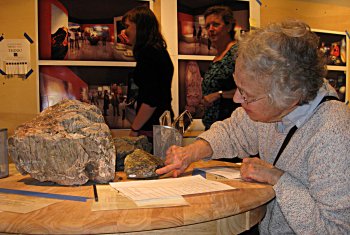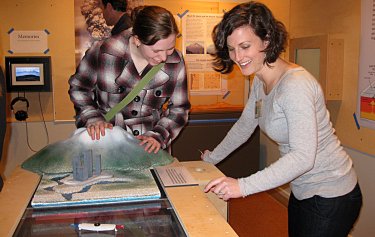EUGENE, Ore. — (March 20, 2012) — The UO Museum of Natural and Cultural History is giving its visitors a chance to test components in a way that will help shape the final design of a forthcoming exhibit about the natural history of Oregon.
 Scheduled for installation at the museum in 2013, the new exhibit "Explore Oregon!" will double the museum's gallery space and complement the current permanent exhibit's focus on the cultural history of the state.
Scheduled for installation at the museum in 2013, the new exhibit "Explore Oregon!" will double the museum's gallery space and complement the current permanent exhibit's focus on the cultural history of the state.
Over the next six months, museum visitors can test hands-on features that demonstrate geological phenomenon such as plate tectonics, volcanoes, earthquakes and tsunamis — as well as concepts such as mammal evolution and environmental stewardship. Feedback from visitors will count.
"It's always been hard for me to visualize how the ocean level on our coastline changes over millions of years, or how geologists could examine rocks from different areas and figure out how they got there," said museum member Sara Chesluk, who attended the exhibit's opening reception. "So I enjoyed visiting the show, touching and taking a close-up look at some very different rocks, comparing specimens of rocks from various Oregon localities — and turning a crank to watch glowing magma emerging from the earth's crust. I was very happy to be invited to give the museum some feedback about areas that I liked and points that seemed confusing."
 By testing specific parts of the exhibit with visitors in the development phase, museum staff will gain an understanding of what messages resonate and how best to communicate some of the complicated geologic and natural history concepts that are covered. Since new components will be rolled out periodically, people are being encouraged to visit many times over the next six months.
By testing specific parts of the exhibit with visitors in the development phase, museum staff will gain an understanding of what messages resonate and how best to communicate some of the complicated geologic and natural history concepts that are covered. Since new components will be rolled out periodically, people are being encouraged to visit many times over the next six months.
The highly interactive process — known as prototyping — was made possible by a competitive grant awarded to the museum by the Institute of Museum and Library Services in July 2011. The UO's museum was among 160 organizations selected from 481 applicants to be awarded Museums for America grants. The grant program supports projects and ongoing activities that build the capacities of museums to serve their communities.
Prototyping is common among science and technology museums that rely on hands-on features to optimize the educational impact of exhibits. The practice dates back to the late 1980s, when federal funds available to museums began mandating that public accessibility and education as central priorities. Prototyping is generally done at larger institutions in major metropolitan areas and is less common for small to mid-size organizations as it requires significant space and resources.
"It is an extraordinary opportunity for a smaller community like Eugene-Springfield to invite the public to participate in a prototyping process," said Patricia Krier, the museum's director of public programming and development. "At the end of the day, if a museum visitor leaves without being able to recount two to three new ideas they encountered, we have not done our job. This process ensures that the final exhibit design creates effective and memorable experiences for the public -- underscoring a core part of our mission, which is to enhance knowledge and encourage stewardship of human and natural history."
About the Museum of Natural and Cultural History
The UO Museum of Natural and Cultural History is open Wednesday through Sunday from 11 a.m. to 5 p.m. Admission is $3 for adults, $2 for seniors and youths ages 17 and under, and $8 for families (two adults and up to four youths). Museum members are admitted free. Guided tours are offered each Friday at 1:00 pm.
Media Contact: Denise Sorom, marketing and communications specialist, Museum of Natural and Cultural History, 541-346-5083, dsorom@uoregon.edu
MNCH on Facebook: http://www.facebook.com/oregonnaturalhistory